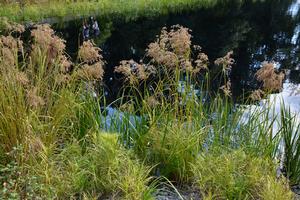Printed at http://www.newmoonnursery.com/index.cfm/

Wool grass is a clumping bulrush for wet areas. Beneficial to wildlife and an excellent soil stabilizer for erosion control.
Scirpus cyperinus
Wool grass
Native to North America
FIRST IMPRESSIONS: Scirpus cyperinus is a rhizomatous perennial that grows in dense tussocks of arching basal leaves. Plants produce upright unbranched culms with ascending or spreading medium green leaves. In summer, the culms are topped with rounded dark green compound inflorescences. Attractive golden brown seed clusters follow. The achene seed have unique bristles that give the seedheads an attractive soft wooly appearance. This contender is much too aggressive for small manicured gardens. Instead the tenacious roots and rhizomes are a boon for wetland restoration projects, rain gardens and soggy sites with erosion issues.
HABITAT & HARDINESS: Scirpus cyperinus occurs in some of the southern Canadian provinces and throughout most of the contiguous United States. The species is absent from 8 midwestern and western states and is most abundant in the Northeast, in the Coastal Plain and around the Great Lakes.
Habitats include sandy or non-sandy wetlands, sedge meadows, gravelly seeps marshes, moist meadows, bottomland prairies, swamps, sloughs, shorelines, ditches and other wet disturbed sites.
This species is hardy from USDA Zones 4-9.
PLANT DESCRIPTION: Scirpus cyperinus is a grass-like aquatic emergent perennial that often forms colonies from short thick rhizomes.
Plants have green triangular or nearly round culms. The upright culms bear 5-9 alternate medium green leaves with prominent green to brown basal sheaths. The blades are linear and 2-3’ long with up to 3/4” width.
In summer, fertile culms are topped by a cluster of compound cymes with 3 or more spreading leafy bracts beneath. The cymes contain ¼” green ovoid spikelets that are displayed on ascending or drooping stalks.
The spikelets mature into golden brown angular achenes. Each achene is covered by 6 reddish brown curly persistent bristles. The bristles give the coppery seed clusters their unique shaggy or wooly appearance. Foliage develops golden brown fall highlights and the showy seed heads persist until the end of the growing season.
Plants are 3-6’ tall with 3-5’ spread.
CULTURAL & MAINTENANCE NEEDS: Scirpus cyperinus prospers in sunny moist or wet sites often with peaty sandy soils. This versatile plant tolerates part shade, occasional dry spells and shallow standing water.
This species readily self-sows and increases by rhizomes. Avoid planting in sites with limited space and vulnerable less aggressive companions.
Plants are relatively pest free and deer resistant.
LANDSCAPE USES: Scirpus cyperinus produces Showy Inflorescences and Ornamental Seed Clusters that provide Fall Color, Winter Interest and sustenance for wildlife. The species is most valuable for Restoration Projects, Erosion Control, large Water Gardens, Rain Gardens and Stormwater Management. Plants are often installed as part of a Grouping or Mass Planting in Wetland situations.
COMPANION & UNDERSTUDY PLANTS: Try pairing with Anemone canadensis, Ceanothus americanus, Carex emoryii, Carex stricta, Carex vulpinoidea, Iris versicolor or Juncus tenuis.
Scirpus validus is a taller bulrush with a less upright habit. Due to comparable cultural needs and somewhat similar appearance, S. validus could be substituted if needed.
TRIVIA: The common names Wool Grass or Cottongrass Bulrush are very misleading. This plant is a member of the Sedge Family (Cyperaceae) rather than a grass or a rush.
The seeds are a good food for ducks, rails and other wetland birds. The dense basal growth provides nesting sites and cover for wildlife.
Height:
3-6 ftSpread:
3-5 ftSpacing:
4 ftUSDA Hardiness Zone:
3-9Bloom Color:
Green, TanScirpus cyperinus Characteristics
Attributes
- Bog
- Naturalizing
- East-Coast Native
- Rain Garden
- Dried Flower
Exposure
- Full Sun to Partial Shade
Flowering Months
- September
- August
- July
Foliage Color
- Green
Grass Season
- Warm Season Grass
Salt Tolerance
- Medium
Season of Interest (Foliage)
- Fall
- Summer
- Spring
- Winter
Soil Moisture Preference
- Wet to Moist
